They say that death is a natural part of life. Nowhere is that more evident than when you are out exploring in the great outdoors. It’s a rare outing for me when I do not come across a skeleton or carcass of some kind—especially when I am hiking off trail. These types of finds can often be fascinating and intriguing. The opportunity to observe and learn about the structural inner workings of many of these creatures is invaluable. And, taking the time to reflect on the events surrounding the demise of the critters is a mystery that is always worth pondering—even if an answer is not always forthcoming. Speculating about what came to pass is an interesting endeavor, and is a big part of what this article will be about—please indulge me!
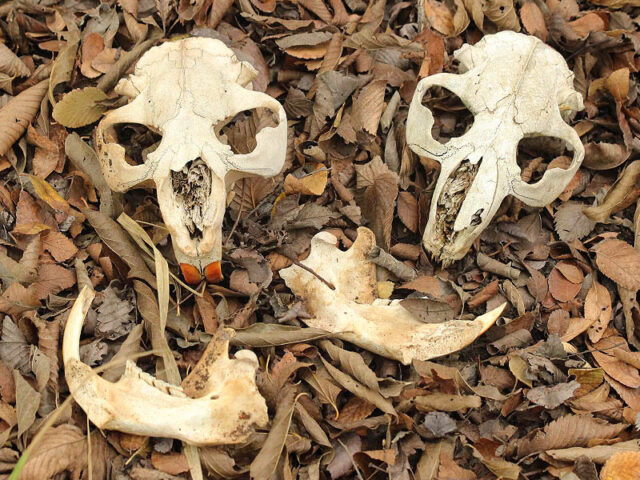
When a skeleton is encountered in the wild, the first challenge is often simply to determine what kind of critter it belonged to. For some animals, even a partial skeleton is enough to make a reasonable identification. Finding a complete skull almost always does the trick. But for other situations, like when an old and scattered skeleton is found, or when the bones of two very similar animals are discovered (think Beaver and Nutria), things may not be so straight forward.
Fortunately, there are many resources online that can help with identifications. Skulls Unlimited is one of my favorites. This company sells replica and ethically acquired real skulls and skeletons. They have an extensive online catalog with the skeletons of local reptiles, birds, and mammals represented in photographs. Googling for images of the specific animal skeleton and/or bone you are looking often produces good results as well. Once you have identified a suitable set of reference photos you can begin the work of making a positive id on the skeleton you have found.
In the eventuality that you do have to resort to internet photos for help with a positive id, remember to take plenty of pictures of the bones you have found while still in the field. With mammals, skulls are typically the most important bones for making good identifications. Be sure and record pictures from many different angles. Get shots of all of the teeth—top and bottom. Notice the size, shape, and number of teeth. The shape of the eye sockets and cranial ridges can aid in determining what type of animal the skeleton belonged to.
After the skull, paws and hooves will likely be your next best opportunity to figure out what kind of skeleton you have found. Many of these appendages are very specialized, and their unique features can be the key to differentiation. Other things to consider are the size of the bones and the location of the find. Some animals are simply going to have larger skeletons than others, and some animals are going to be more prevalent in certain habitats. All of these things can offer clues.
Birds skeletons are a little different. Often there are feathers present, as they can sometimes persist for nearly as long as bones. In many cases feathers are even more useful for making identifications. A good online resource in this case is the US Fish and Wildlife Service Feather Atlas. This great website catalogs the flight feathers of birds organized by order, family, and species (and sometimes subspecies). Often the difference between male, female, and juvenile feathers is clearly illustrated.
Revelations about how the deceased animal perished is sometime possible, but it usually takes a little investigatory work. Broken bones might indicate a predator attack, or possibly a bullet impact. The conditions in the immediate environment might also be telling. Fish bones found in a dried ravine or pond bed are surely victims of a drought. Skeletons discovered near train tracks might indicate a collision occurred. Keep an open mind and consider many possibilities!
Beaver
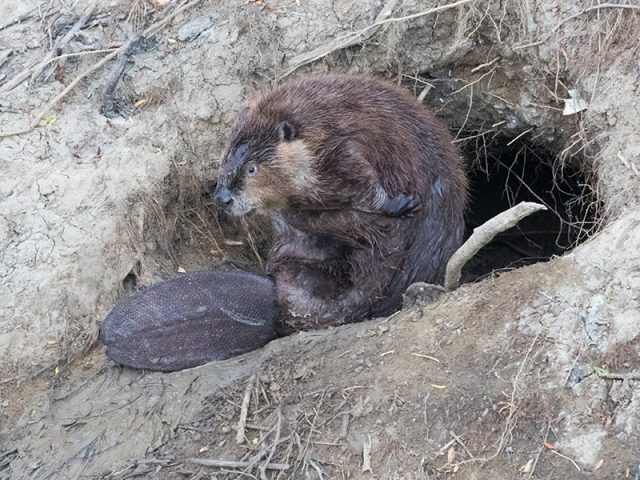
It would seem that the type of skeletal remains I encounter most often belong to the North American Beaver. I certainly have more pictures of their bones in my catalog than those of any other animal.
Beavers are very common all across the metroplex, and their population numbers are certainly very healthy throughout North Texas. I can expect to find Beaver sign just about anywhere in Dallas/Fort Worth that the habitat is even remotely suitable. That includes places like the wild Trinity River and its feeder creeks, all the way to suburban drainage ditches and business park water features.
I’m not sure exactly what accounts for the frequency that I discover Beaver skulls and skeletons. Perhaps it is because they have very specific habitat needs, and any disruption—like drought—can put these big rodents in peril. Without the retreat of water, they may fall prey to our capable, medium-sized predators, the Bobcat and Coyote. Roadkills, old age, and disease are also certainly factors, and I’m sure scavengers can scatter these remains far and wide.
I have found Beaver skeletons in places where the ecosystem and sign would suggest they should be plentiful. I have also discovered Beaver bones far from places I would consider optimal habitat. I have come across multiple skeletons at a single location. I have happened on skulls with deformities. Examples are provided in the pictures below…


which may have contributed to the animals demise
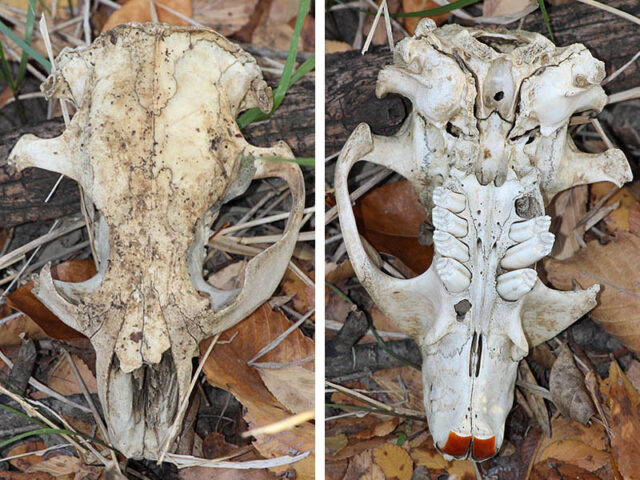

and oils are still leaching from the bones
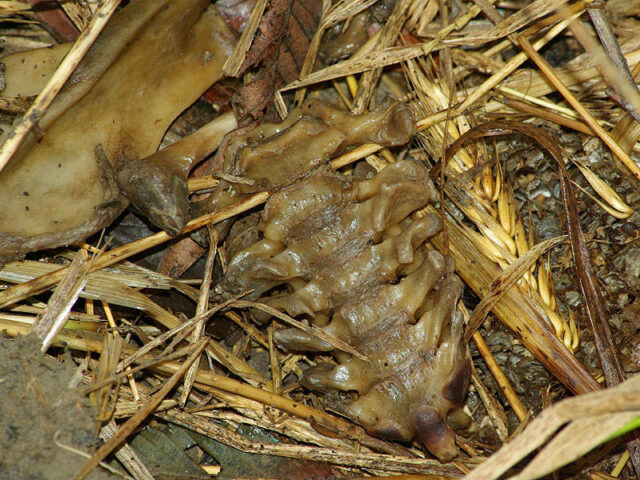

inclination for mischief—hung this Beaver skull in the branches of a small bush.
Double-crested Cormorant
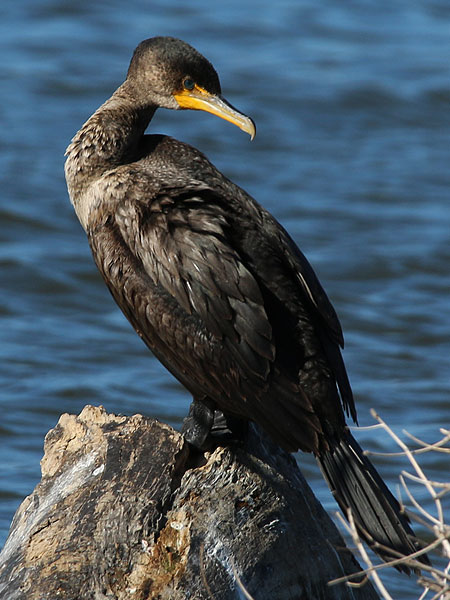
The Double-crested Cormorant carcass in this example was an interesting find. I stumbled across it late one winter while exploring in the Trinity River bottoms with a friend. The skull—which was the key to identifying this bird—was buried beneath a mass of black feathers, and a little digging was required to uncover it. My friend and I paused momentarily to consider the remains, and then we continued on our way.
As we walked, we discussed possible explanations the bird’s demise. Double-crested Cormorants are waterfowl. They spend most of their time in the water, on the wing, or roosting in tall trees near rivers and lakes. It seemed odd to find a cormorant carcass here in the woods, nearly a quarter mile away from the nearest suitable body of water.
In the end we decided that the most likely explanation for this set of circumstance is that a predator somehow managed to get the drop on a grounded cormorant, and then carried the carcass here to feed in relative seclusion. Our guess is that only a Coyote would have the stamina to carry the carcass this far from water before stoping to eat.
As for how a Coyote might make a kill like this… Maybe the bird was sick or injured when the Coyote came along. Or possibly the cormorant simply let its guard down in a spot close enough to the shore for a Coyote to make an attempt. Double-crested Cormorants dive under the water to hunt for their preferred prey (fish, crustaceans, amphibians). A clever Coyote might have learned to anticipate a cormorant’s return to the surface as a moment of vulnerability. A stealthy Coyote might move into position while the bird was under water, and then quickly pounce just as the cormorant breached the surface. That would be a fascinating thing to see!
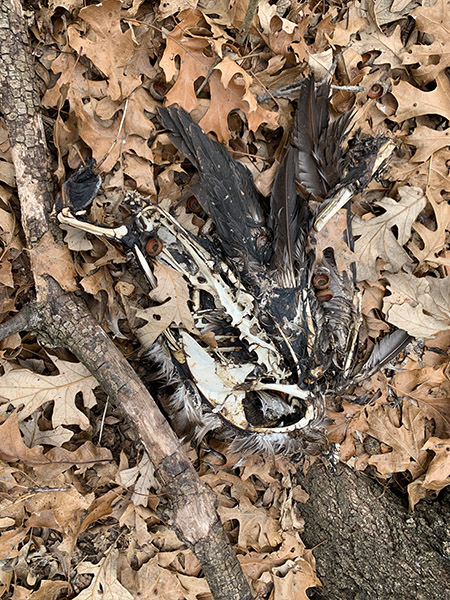

When I returned to this part of the woods several months later, just by coincidence the route I followed again led me straight to the old cormorant skeleton. This time many more of the bird’s bones were exposed, including the cormorant’s unusual looking pelvis. See the pictures below for a comparison to an articulated skeleton.
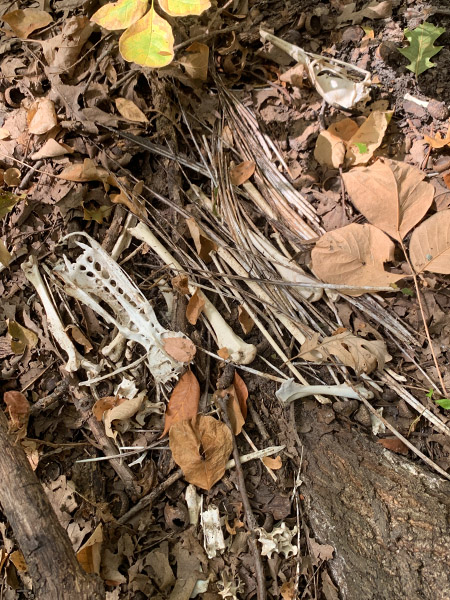

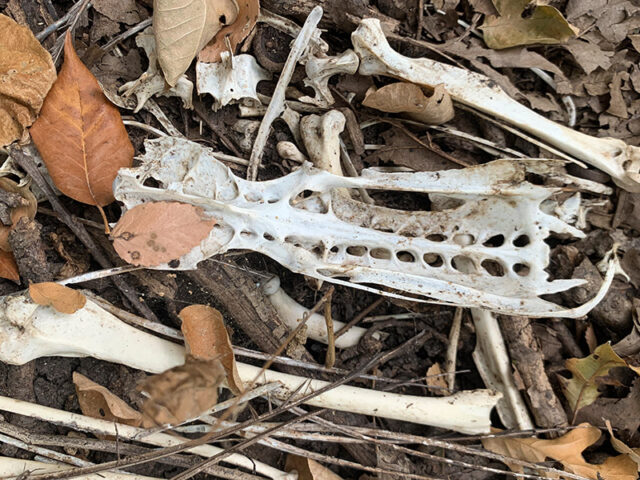

Raccoon
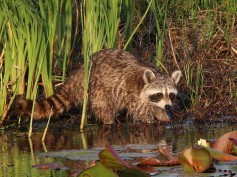
In terms of sheer numbers, Raccoon skeletons come in a close second to North American Beavers. That’s really no surprise, as Raccoons are one of the most adaptable and successful animals living with us here in the city. Dallas/Fort Worth is home to a whooolllee lot of Raccoons.
Despite their success, Raccoons remain vulnerable to a number of threats and dangers. Young Raccoons can fall prey to Coyotes and Bobcats. Automobile traffic takes out more than its fair share of intrepid Raccoons. Diseases such as distemper can run rampant through the Raccoon population in some years. And of course, the Raccoon’s propensity toward mischief—and the trouble that results—certainly contributes to the demise of many of these critters as well.


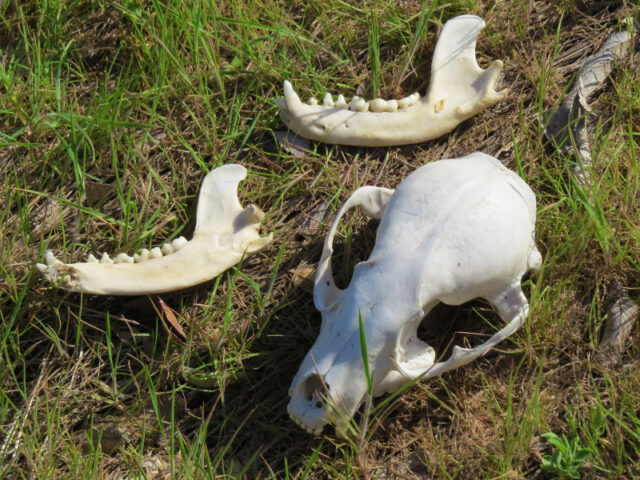
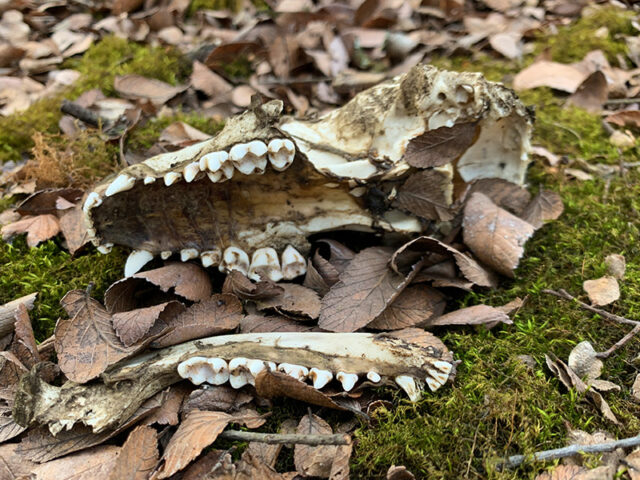



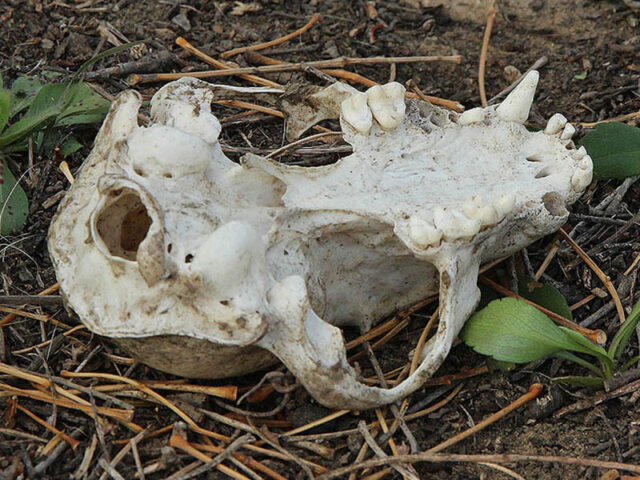


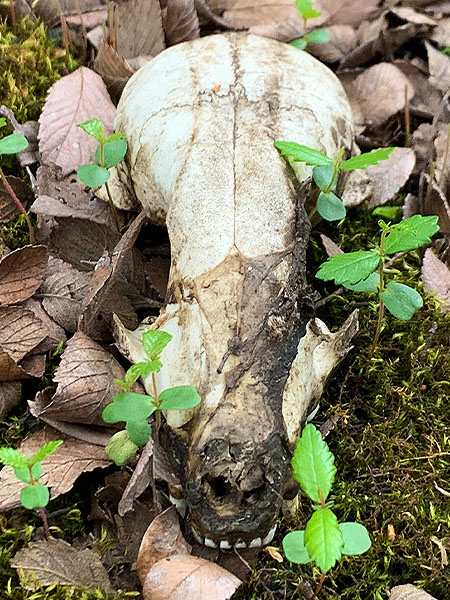
the victim of a predator?
White-tailed Deer
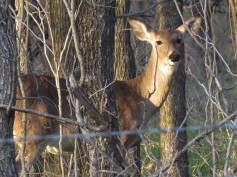
There are no predators in North Texas that are capable of bringing down an adult White-tailed Deer under normal circumstances. That means that when a deer carcass is encountered in the wilds of Dallas/Fort Worth there must be some other explanation for the animal’s demise. Disease, injury, old age, and collision with automobiles all qualify as possibilities.
A good number of the deer carcasses I have encountered while exploring outdoors have been found in close proximity to railroad tracks, suggesting that an unexpected nighttime encounter with a train may have done them in. Often the skeletal remains I find in these instances are incomplete and several hundred yards from the train tracks. Coyotes feeding on these deer kills certainly carry off any manageably-small pieces to places where they can eat without competition from other scavengers.

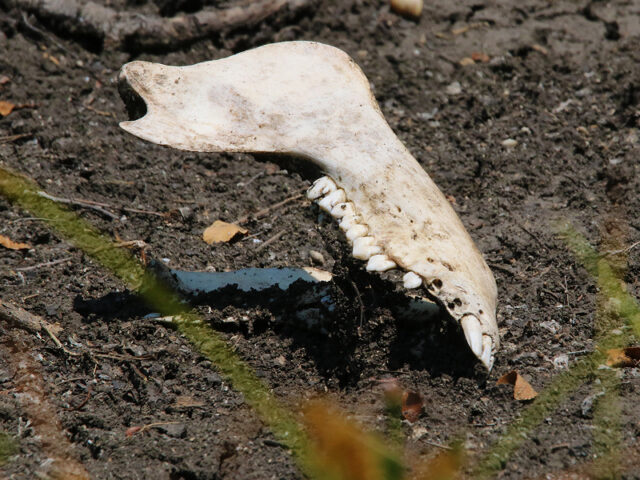
The rest of the skeleton could not be located

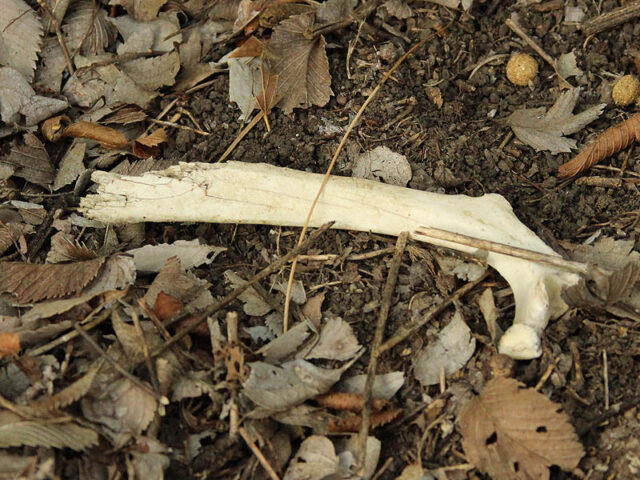
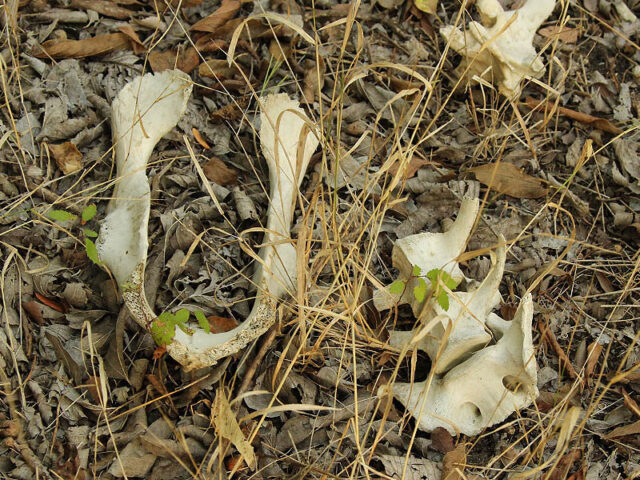

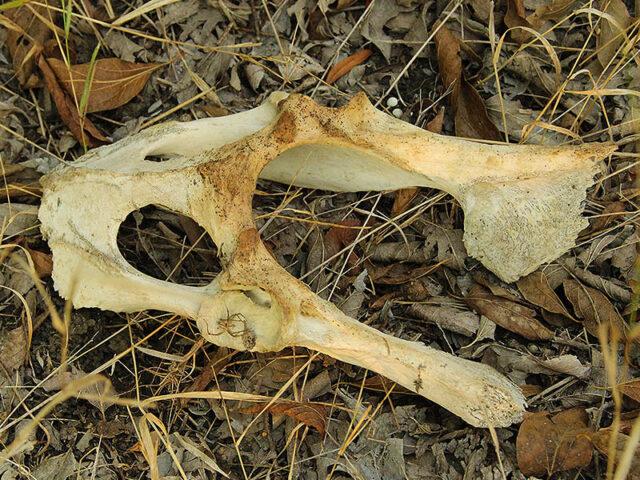
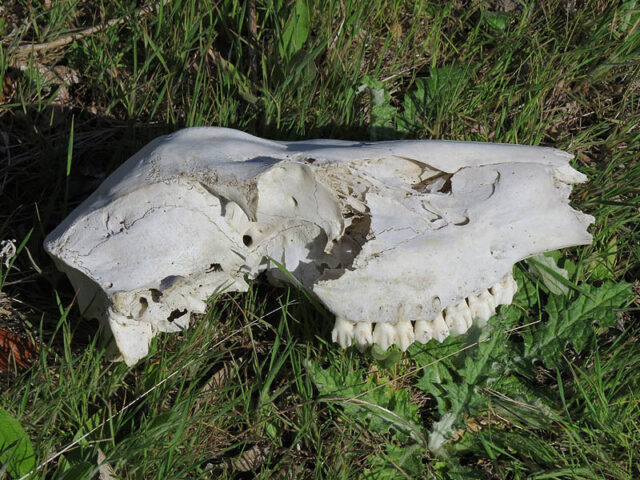
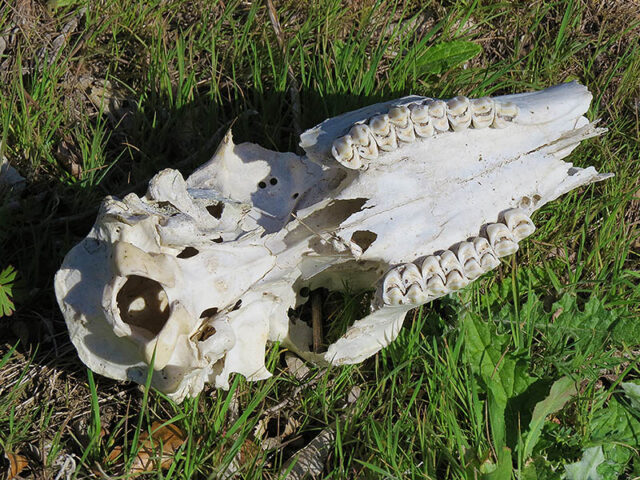


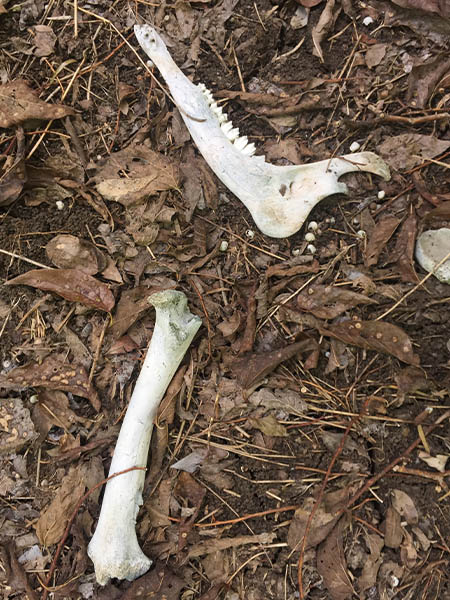
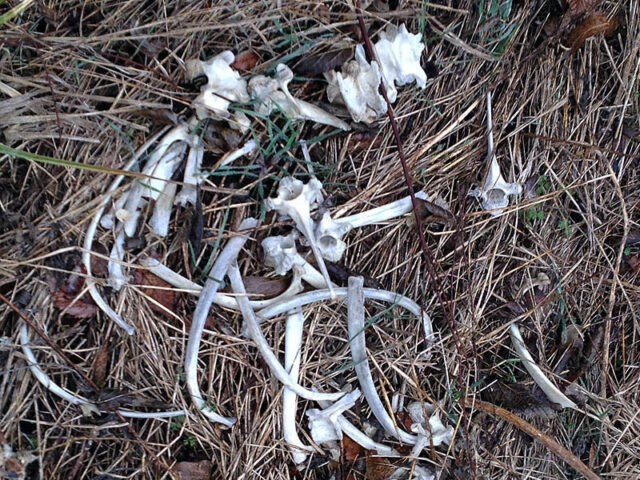
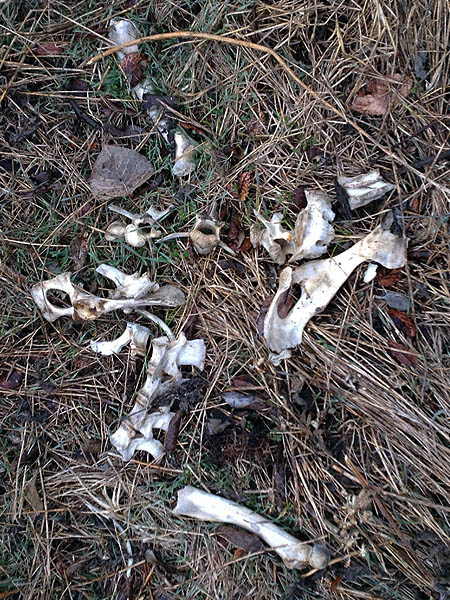
Another possible cause of death for White-tailed Deer is injury incurred when big males engage in sparring. I’m not sure how often injuries resulting in death occur, but I have seen evidence that it does happen. Sometime a pair of bucks will get their antlers locked—a death sentence for both animals. And I have recorded many trail camera images of bucks with an eye missing—a loss that is surely the result of a sparing injury in most cases.
I recently discovered a White-tailed Deer skull showing evidence that sparring may have been the cause of death. Take a look at the skull in the photographs below. The old, rodent-gnawed skull still has one antler attached. When I flipped the skull over I found that the other antler had been broken off, taking a good deal of the skull bone along with it. It is possible that the antler was broken off postmortem—there’s no way to be sure. But, if this antler did come off during a sparring match, the resulting injury was certainly a mortal one.


of the supporting skull bone, is missing
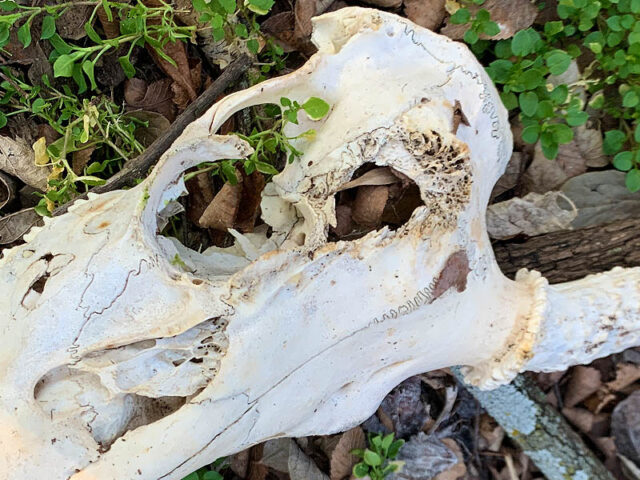
Alligator Gar

I discovered the small Alligator Gar skeleton pictured below deep in Dallas’ Great Trinity Forest. It was an odd and unexpected find. A little research was required to develop a working theory of how this fish came to expire at this surprising spot on the forest floor. According to imagery found on the Historic Aerials website, decades ago this place in the woods was crossed by a dirt road. The road is now long gone, nearly completely obliterated by the encroaching forest. But there are still some signs of how things looked here in the recent past.
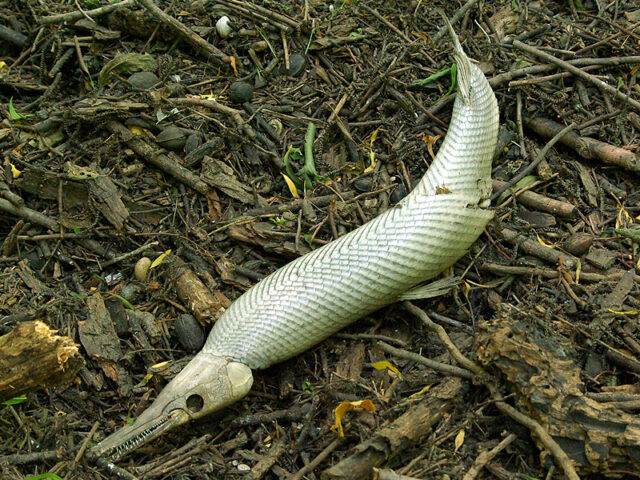
One of the of the most obvious indications that a road was once here was a corrugated metal pipe wrapped in a tangle of tree roots and suspended in midair (see picture below). This pipe had once been installed as a culvert under the the old farm road. The pipe’s purpose was to facilitate the flow of water in a small gully on its way to the Trinity River just a short distance away. Over the years, the Trinity River periodically flooded this area, eroding away the road and leaving a bowl shaped basin in its place. Certainly during a recent over-banking, this Alligator Gar found his way to the basin and was trapped there after the flood waters receded. The gar had no way to escape as the pool slowly evaporated in the heat of the summer. When the water was gone, the unfortunate gar was left to perish here at this spot.

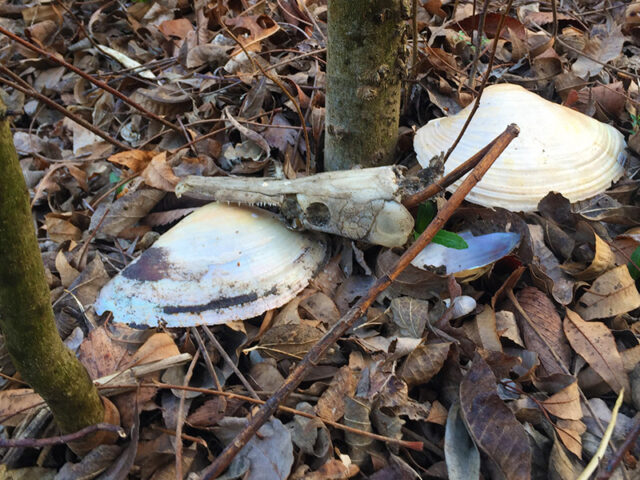
Striped Skunk
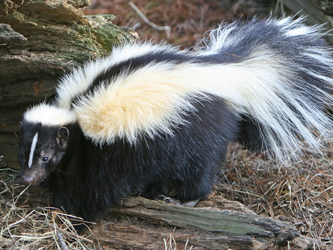
We are all familiar with the skunk’s formidable defense strategy. Striped Skunks come equipped with a powerful chemical defense. Skunks are very confident in their protection, and they often are found presenting an attitude of invulnerability as they go about their business. Most predators know to give the skunk a wide berth. The skunk’s striking black and white coloration does not work as camouflage… it is meant as a warning.
But not all predators are deterred. Striped Skunks often fall prey to Great Horned Owls. Owls—like most other birds—do not have a great sense of smell. This fact likely leaves them largely unimpressed by the skunk’s stinky arsenal.
It is also reported that Bobcats will occasionally take a skunk. Bobcats certainly use their speed and agility to avoid a spraying. I have even recorded trail camera footage, a time or two, that appears to show a Bobcat carrying a freshly killed skunk.
Skunks are also the primary vector for rabies in Texas. That means that a sick or recently deceased—but uninjured skunk—may have fallen victim to this disease. For that reason alone, it’s a good idea to stay well clear of these carcasses.
Fortunately, nature has provided a cleanup crew in the form of Black Vultures and Turkey Vulture. Rabies is a disease of mammals, and birds do not catch it. That means that a vulture can feed heartily on a skunk carcass without becoming infected.
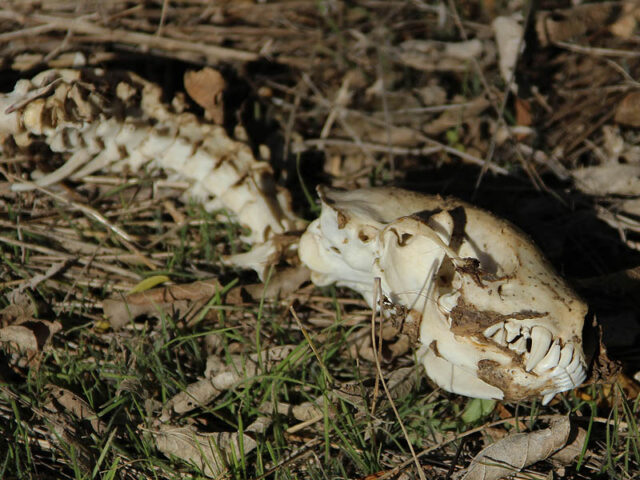
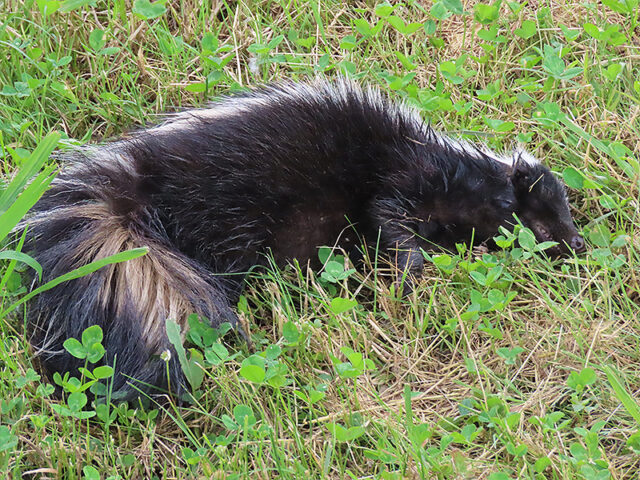

Three-toed Box Turtle

This example is compelling because of the concern many people have for the fate of box turtles in Texas. For a number years now there has been anecdotal evidence that the box turtle population in Texas is in decline.
We have two species of box turtles in Texas—the Three-toed Box Turtle (Eastern Box Turtles) and the Ornate Box Turtle. Both species seem to be in trouble. The concern is such that Texas Parks and Wildlife has created a special iNaturalist project designed to help gather information about box turtles numbers and distribution throughout the state.
ARTICLE: Where Did All the Box Turtles Go?
The skeletons in the pictures below belong to a pair of Three-toed Box Turtles. What is unusual about this discovery is that the two skeletons were found just inches away from each other. In a time when box turtle numbers seem to be in decline—when it is rare to come across one, much less two—I had to wonder just what set of circumstances could lead to the death of a pair of these reptiles in such close proximity to each other?
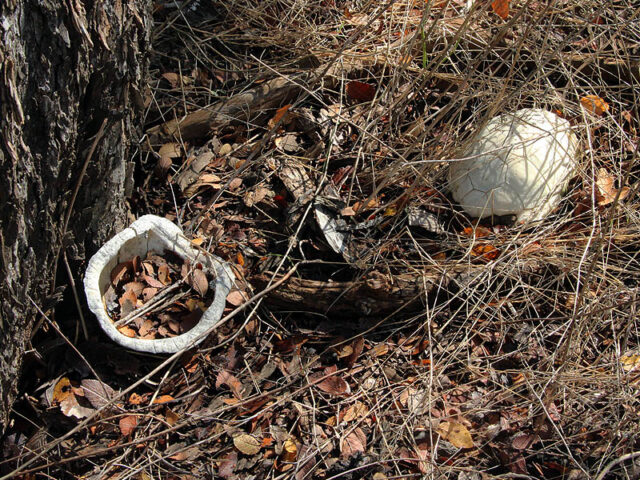

My best guess is that some predator got the drop on this pair while they were engaged in—and preoccupied with—mating. Further, if you look closely the larger carapace, you will find that it has been broken. There is an X-shaped crack located almost dead center on the shell. That looks to me like damage done through the application of excessive pressure—like something bit down hard on the carapace. I suspect that only a canine would be able to fit a turtle shell far enough into its mouth to apply a bite like that. So, if all of these assumptions hold, it seems likely that it was a Coyote that did in this unfortunate pair.
Common Musk Turtle
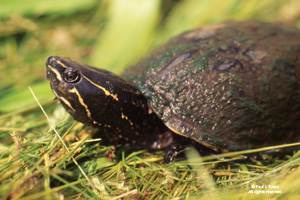
In the case of the Common Musk Turtle shell shown in this example, this find is import for no other reason than it confirms that this species of turtle is or has been present in this particular habitat—a data point that is often interesting and informative to have positively established.
And even though there is no obvious cause of death to be found on this old carapace, it is still possible to make an educated guess about how this turtle may have met his demise. Water turtles like the Common Musk Turtle are inspired—for various reasons—to wander away from whatever body of water they are currently calling home to go in search of a new one. Sometimes their current pond may be overpopulated. Other times the body of water may be drying up, or maybe the weather is rainy and accommodating. Many times it appears that a turtle just developed the wanderlust.
Whatever the case, a wayward turtle will leave its current watery home and head out across dry land in search of a new one. If he is lucky, he will find his new home close by and be back in the water again in short order. But if a new body of water is not in close proximity, a roaming turtle can flounder and may perish far away from a wet environment more suited to its needs.
The turtle shell pictured below was found in the forest several hundred yards away from any suitable body of water. It is my guess that this Common Musk Turtle met its demise while searching—without success—for a new pond to call home.

Common Snapping Turtle
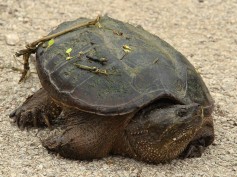
This was a discovery I nearly missed. Below you will find images of the shell of a juvenile Common Snapping Turtle. The small carapace would have fit on a silver dollar with room to spare, and as you can see, it is very well camouflaged against the forest floor detritus. I spotted the small skeleton as I hurried along, but it took a second or two for what I had seen to register.
When the realization finally struck me, I quickly stopped and turned back to have a closer look. So well disguised was the turtle shell, that it took a moment or two of searching before I was able to locate it again. I picked carapace up to examine it more closely, and when i flipped it over I was stunned to see the complex inner working present on the underside.


This particular turtle was just barely more than a hatchling, and it is not clear what did it in. But, as Darwin posited, many more offspring are born than can possibly survive. It is likely that this little guy just was not fit enough to make it to water after he hatched. It is also possible that the turtle was intercepted by a hungry Raccoon before it was able to make it to the safety of the near by creek, although I might have expected more damage to the carapace in that scenario.
Feral Hog

Feral Hog are considered an invasive species, and it is said that they can do millions of dollars of agricultural damage every year. These wild pigs may very well be the least popular animal in the universe. Deserved or not, they are vilified and persecuted throughout the state of Texas.
Feral Hogs have been in Texas since the Spanish first released them here 500 years ago. But they only emerged as a real problem over the last several decades—an outcome likely related to the proliferation of hunting leases across the state.
SMITHSONIAN – A Plague of Pigs in Texas
There are many more Feral Hogs in the Dallas/Fort Worth metroplex than is generally recognized—still their presence goes unnoticed by most. In the river bottoms of North Texas the impact of the presence of Feral Hogs is relatively benign. The effects of their rooting and wallowing are typically irradicated with the coming of spring rains and the new vegetation growth that follows. Hog sign that was abundantly obvious in the fall and winter, is scrubbed away by the changing of the seasons.
I don’t come across Feral Hog carcasses very often, but when I do, it is unusually safe to assume the wild pig was killed by a poacher or someone engaged in a culling operation. Adult hogs are too large and powerful for predators like Coyotes and Bobcats to kill under ordinary circumstances, and that leaves human hunters as the most probable explanation in most cases. And because the vast majority of land that I access for wildlife photography in DFW is not open for hunting, most of these kills are the result of poaching—an illegal activity that is likely rationalized by the hyper-vilification of these animals.
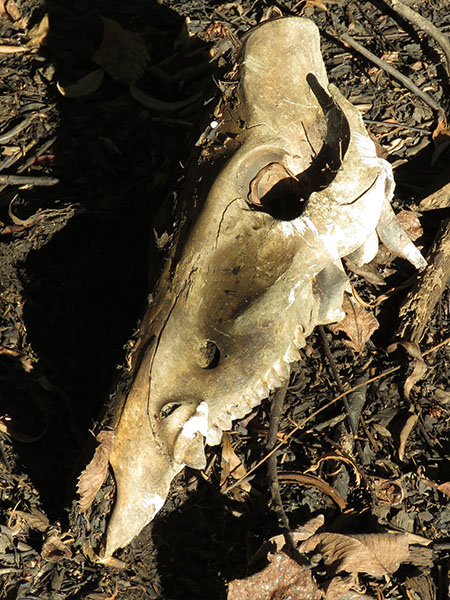
Great Horned Owl
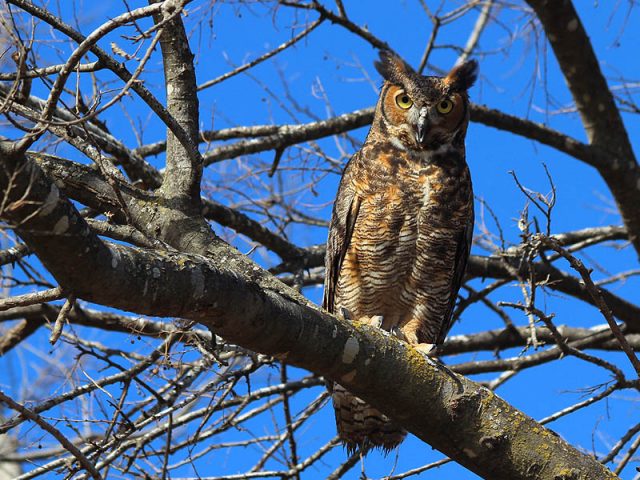
This Great Horned Owl carcass was something of a surprise to find. Great Horned Owls are the largest species of owl living in Dallas/Fort Worth. They are mighty avian hunters, but from the looks of things, some other predator managed to get the drop on this owl while he was on the ground.
Great Horned Owls will hunt any type of animal that it has the ability to subdue. Everything from small mammals, reptiles, amphibians to birds up to the the size of Canada Geese. The’ve even been know to capture and kill Striped Skunks (more about that later).
In the case of this particular owl, my guess is that the big predatory bird took on a prey animal that it had difficulty dispatching quickly. Under the cover of darkness, another predator—maybe a Bobcat—lurked nearby. It’s possible the Bobcat was just in the general area incidentally and was drawn to the sounds of the owl struggling with its prey. Or, maybe the Bobcat was stalking the the same prey just before the owl made its move. Either way, the Bobcat likely found the preoccupied owl to good of an opportunity to pass up!
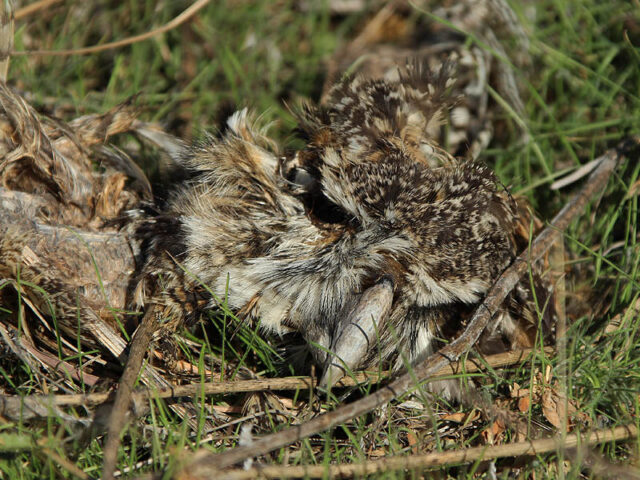

Barn Owl
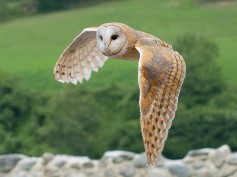
These Barn Owl remains were found in the same general location as those of the Great Horned Owl above. I discovered this pile of feather just a few weeks after I had stumbled across the Great Horned Owl carcass.
It would seem that there was a predator in this part of the prairie who was working to prefect his technique for ambushing preoccupied owls on the ground. My guess is that the circumstances in this case very closely resemble those of the Great Horned Owl described above. Once again, it seems very likely that our culprit in this case was a crafty and capable Bobcat.

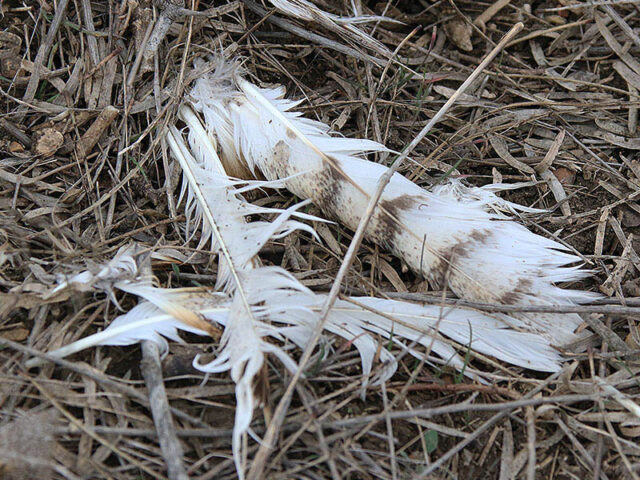

Coyote

Coyotes are another animal whose skeletal remains I seldom stumble across, and I’m not sure the exact reason why.
Over the course of several years, I have spent a considerable amount of time observing Coyote family groups in my neck of the metroplex. I have seen their comings and goings. I have witnessed family groups displaced from their territories by stronger and more aggressive Coyotes. I have noted the loss of certain individual Coyotes. But I have never found their carcasses with any regularly.
Predators like Coyotes tend to die from the consequences of injury or age related infirmities. With the exception of roadkills, Coyotes in the metroplex certainly follow this pattern. And a Coyote unable to hunt for these reasons will begin a slow but steady decline. Coyotes in this condition surely retreat to the safety of dense cover as their fitness deteriorates, and that may be as good as explanation as any for why their remains are not frequently discovered.

House Cat

House Cats and the outdoors are not always a good combination. Ordinarily, House Cats can live as long as 15 year of age or more. But statistics indicate that cats who spend much of their time outside have a much reduced life expectancy—some say outdoor cats average as little as two years. That’s quite a difference.
House Cats are clever and capable animals, but that doesn’t change the fact that there are many dangers waiting for them outside the home. As is the case with nearly all animals in North Texas, automobile traffic may be the single most pervasive threat to outdoor cats. After that there is disease and hunger. And because of their relatively small size, House cats can become vulnerable to larger predators such as Coyotes and Dogs. Large birds of prey—particularly Great Horned Owls—have also been known to occasionally hunt and kill House Cats.
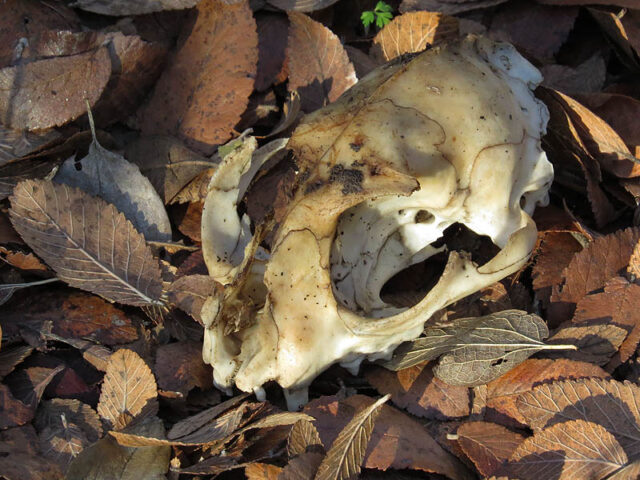
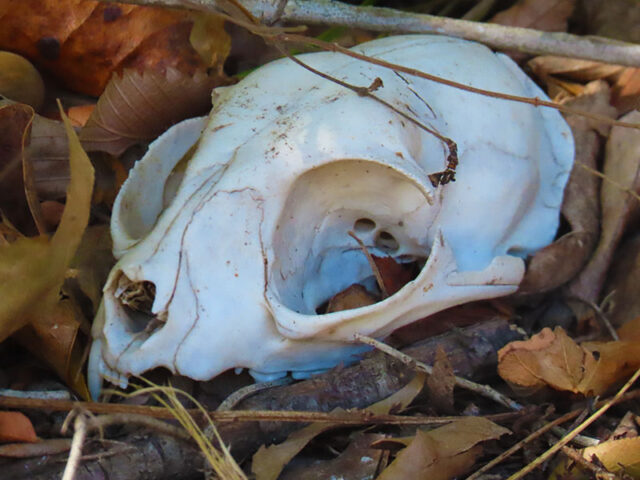
I have come across partial cat carcasses on several occasions. Each time the cat was found deep in the woods, far from houses or apartments. The only thing certain about each discovery is that the cats succumbed to the challenges of living outside. Disease, predators, or scavengers were surely the most likely explanations for the cat carcasses I have found, but which was the exact cause has always remained up for debate.
Horse
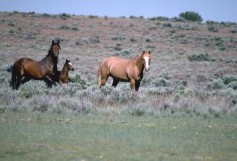
There are many places around the metroplex where you might expect to stumble across a Horse skeleton, but unfenced, public land is not at the top of the list. Nonetheless, that is exactly where the bones pictured below where discovered.
Several years ago I picked up on rumors about a small herd of free ranging horses living just a few miles from downtown Dallas in a remote wooded area near the Great Trinity Forest. Eventually, I decided to stop by to investigate for myself. The story is documented in the short blog post linked below…
ARTICLE: Mustang – Free Ranging
The herd was said to be on a parcel of land including public and private property. The land was unfenced, but was nonetheless bounded by development and a thick perimeter of trees. Five Mile Creek cut across the south end of the property providing a reliable source of water.
By the time I made it out to investigate the horses were long gone. My suspicion is that they had been rounded up or recaptured. But as I explored the property, it didn’t take long to find evidence that horses had been there in the recent past. Of note were a number of skeletal remains. See the photographs below…
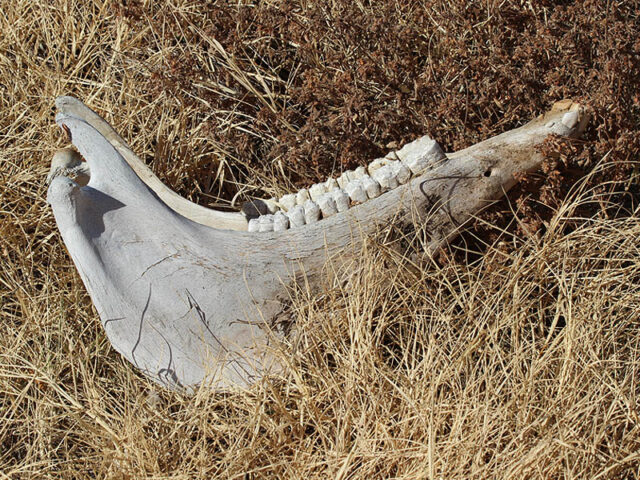
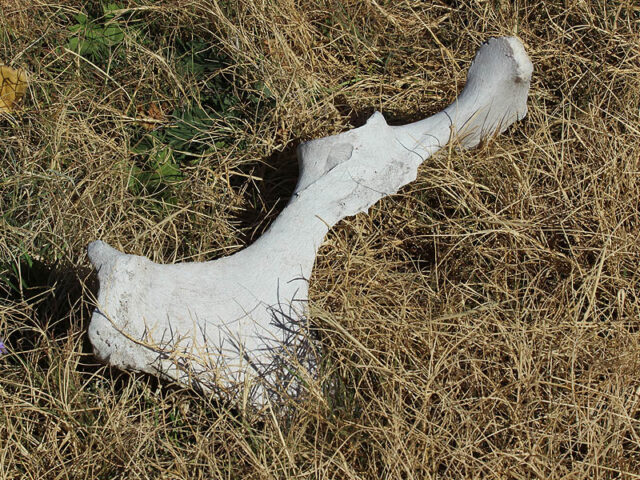
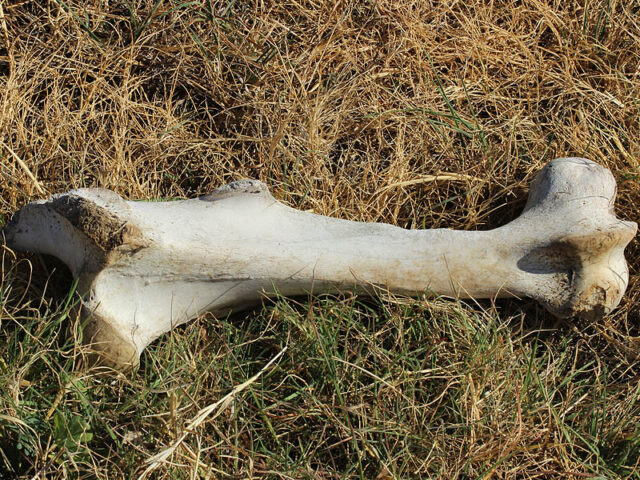
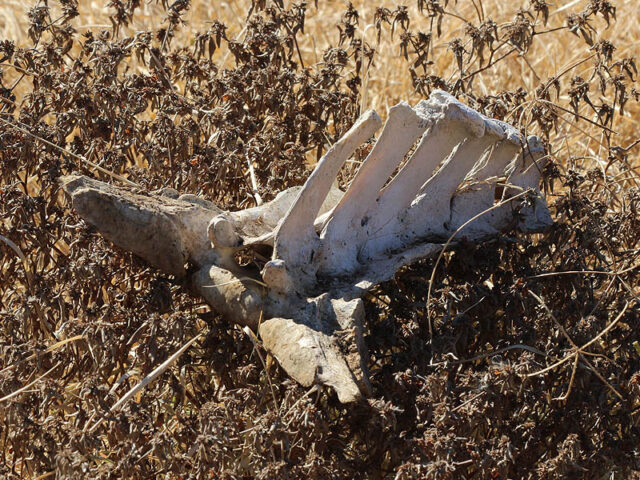
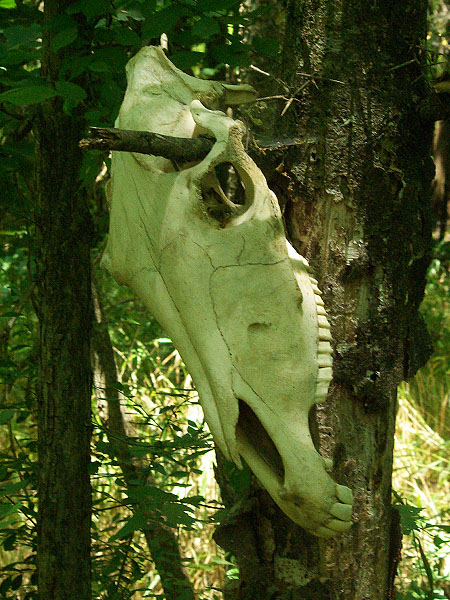
on the grounds of an abandoned ranch
Armadillo
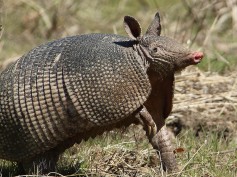
Sometimes and animal just dies and the cause of death can never be discerned. Disease, old age, drought, famine, or just plain bad luck. The universe giveth and the universe taketh away.
The Armadillo is odd animal. These critters have poor vision and hearing, which results in a decidedly diminished level of situational awareness. Anyone who has ever observed Armadillos in the wild can attest to this. If you keep quiet, and move slowly and deliberately in the presence of an Armadillo, the animal is unlikely to recognize that you are there—Even when you are close enough to touch.
Despite this seeming vulnerability, Nine-banded Armadillos thrive in North Texas. They can often be found in the margins of wooded areas with their noses down, rooting through the forest floor detritus. On some days I encounter Armadillos, and other I do not. On those ocassions when I do observe Armadillos, I tend to find many individual animals as the morning progressive—it’s often an all or nothing type of situation.
Even though Armadillos are plentiful in North Texas, I seldom come across Armadillo remains when exploring outdoors. Somehow these intrepid little critters successfully manage to avoid predators and other dangers out in the field (roads and automobile traffic are another story). I’m sure their unique armored plating helps make up for the defenses armadillos are lacking in other areas.
In the case of the Armadillo bones illustrated below, the case of death could not be determined—or even guessed at. But I did want to share with you a look at this animal’s unusual pelvis, skull, and fused tibia/fibula from its hind leg.
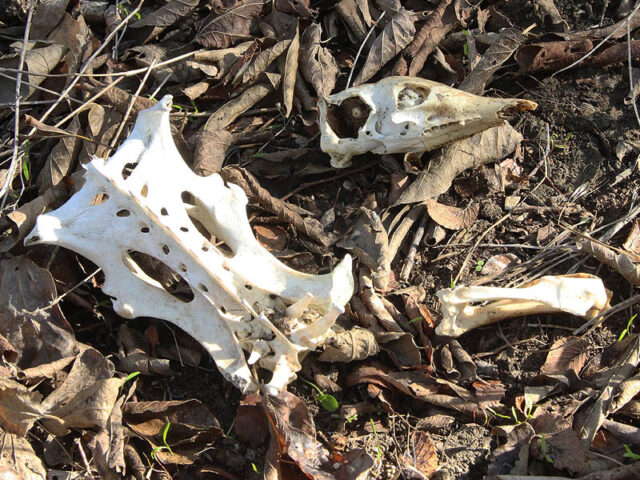
Spiny Softshell Turtle
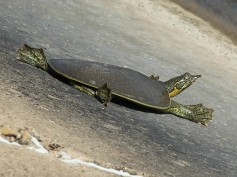
Spiny Softshell Turtles are one of the largest freshwater turtles living in North Texas. Females of this species can grow to be nearly 19 inches in diameter. That’s larger than many dinner plates!
The Spiny Softshell Turtle’s carapace is a little bit unusual for a freshwater turtle. It is flat, soft, and rubbery, rather than domed and hard, as is the case with most other turtle species. Combined with the Spiny Softshell Turtle’s large webbed feet, these adaptation likely work together to improve swimming efficiency.
This difference is also reflected in the unusual bone structure of the carapace skeleton. See below for an example of a shell from a big female Spiny Softshell Turtle which was found on the mudflats of a dried up small lake.
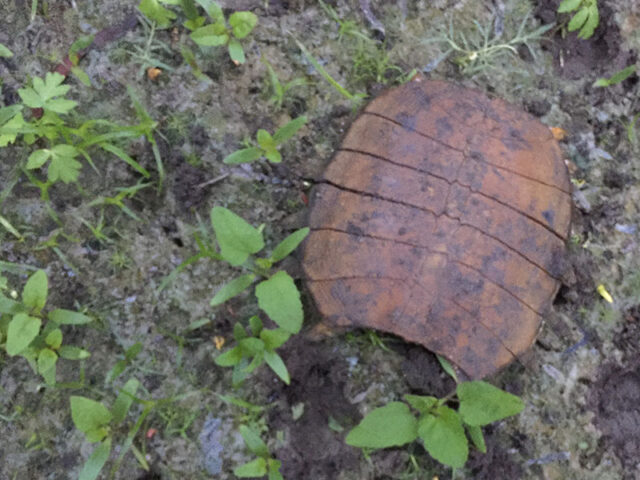

Cattle
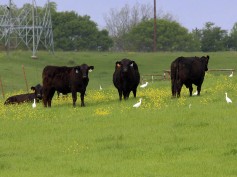
It is not unusual for large cattle operations to lose some of their livestock to various causes of death each year. And when an animal as large as a domestic cow perishes it can become a bonanza for wild scavengers. A carcass can be stripped clean and the bone scattered about in only a matter of days.
Every scavenger you can imagine will partake of the bounty. Birds such as vulture, caracaras, and crows will feed on the deceased animal. Even birds of prey—like hawks and Bald Eagles—will scavenge a fresh carcass. Coyotes, Bobcats, Raccoons, Opossums, rats, and other mammals will eat their fill. In warm weather, insects will do the minute work of stripping the bones clean.
The skeletons illustrated below were found in the depth of winter and were only a month or so old. Despite the cool weather the bones had still been denuded of nearly all soft tissue.



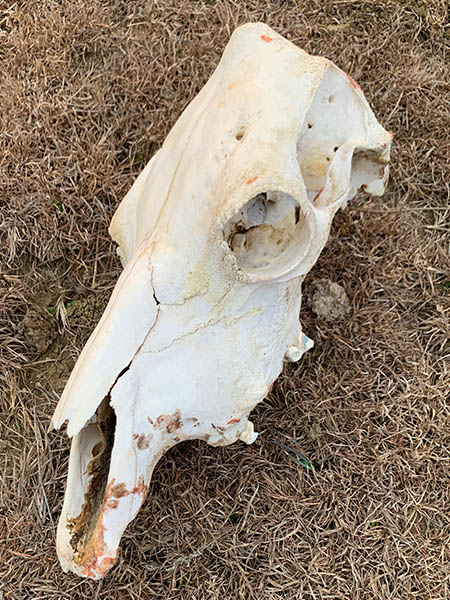
Black Vulture

This Black Vulture entry follows the one for Domestic Cattle for a very specific reason—the vulture skull illustrated in this section was one of several found on active ranchland mixed in with the remains of a number of deceased cows.
This small corner of the property had been set aside by the ranch operator as the place to dispose of his deceased stock. And whenever a fresh cow carcass was brought here the local vultures surely followed close behind. Black Vultures in particular gather in large numbers around a carcass as substantial as that of an adult cow.
So what explains the deaths of the vultures? My guess is that it was a ranch hand with a gun. No one likes to lose livestock. Seeing a group of rambunctious Black Vultures making a meal of that same animal is certainly chafing to some.
Brash vultures can hold steadfast to carcass even when threatened. They would likely tolerate a close approach, and are large enough to be easy targets. A small calibre weapon would suffice, and it is likely that some of the vultures would stay on the carcass despite the weapon’s report and the falling of their comrades. Many birds could be killed in one sitting.


Bobcat
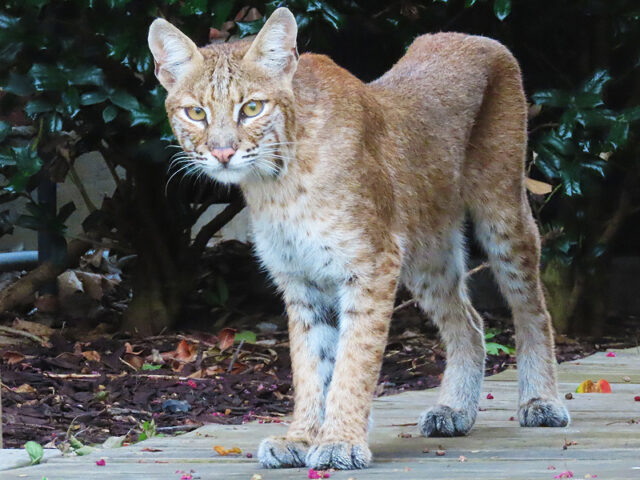
Below you will find pictures of a nearly intact adult Bobcat skeleton. This was a rare find for me, as I seldom come across a complete set of predator bones like this one. I stumbled upon this carcass in a relatively remote part of South Dallas County. There are not many homes or businesses near this part of the Trinity River bottomlands, but there are some nearby hunting and fishing clubs, and at least one organization engaged in avian husbandry—a set of happenstances that may provide a few clues to what happened to this wild cat.
My guess is that this Bobcat was killed with a gun. Taking the location into consideration, it seems likely that the big cat was shot by either a hunter, a poacher, or someone engaged in predator control. The fact that the carcass was left in the field may add credence to the idea that predator control was the motive for the shooting. But it is also possible that a hunter’s bullet did not immediately kill the animal, and the Bobcat was able to flee some distance before succumbing to its wounds. If the varmint hunter was unable locate the carcass, he couldn’t collect his kill.
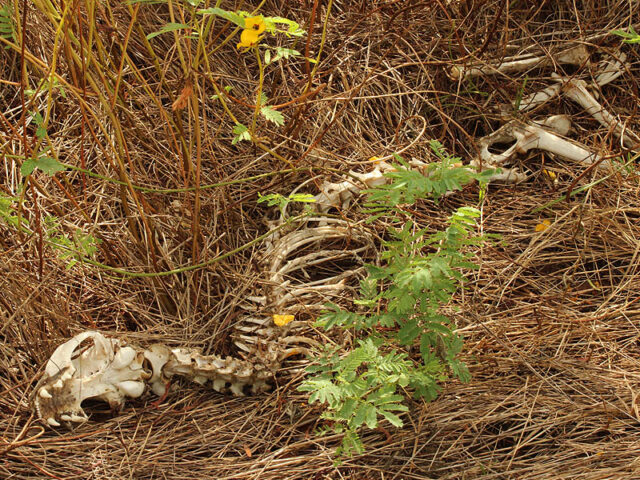
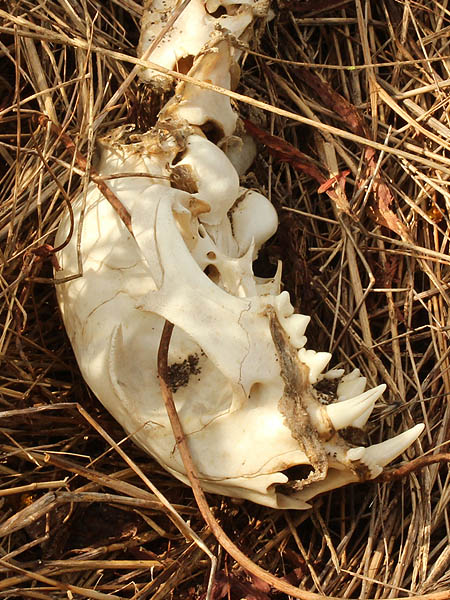
indicating a relatively recent death
Giant Floater
Texas summers can be brutal. The intense heat can be especially hard on smaller bodies of water, where evaporation can easy outpace the refilling capability of a rare summertime rain shower. When precipitation has been lacking, many North Texas ponds and creeks shrink—or even disappear altogether.
Like most ponds in the area, the one in this example has contracted due to an extended drought. The water has retreated several yards from the normal shoreline leaving large portions of the pond bottom exposed.
In the photographs below you will see the remains of hundreds of freshwater mussels left stranded as the pond dried up. I believe these are Giant Floaters (Anodonta grandis), one of the most common freshwater mussel in this part of Texas. These mussels are called “Giant” for good reason—the largest shells in this group are approaching 6.5 inches in length.
All of the mussels in these photographs are deceased. In fact, all that remains are their hard, calcium carbonate shells. It’s not clear how these mussels met their end. Although it is likely that many survived the initial drying of the pond, only to be dug out of the mud by scavengers such as Raccoons, herons, and egrets.

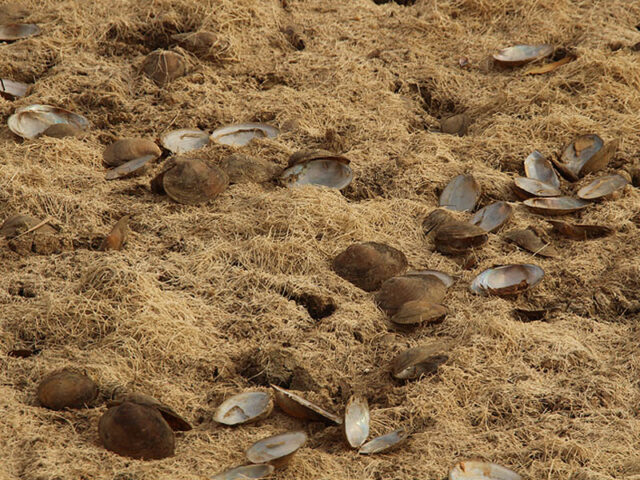
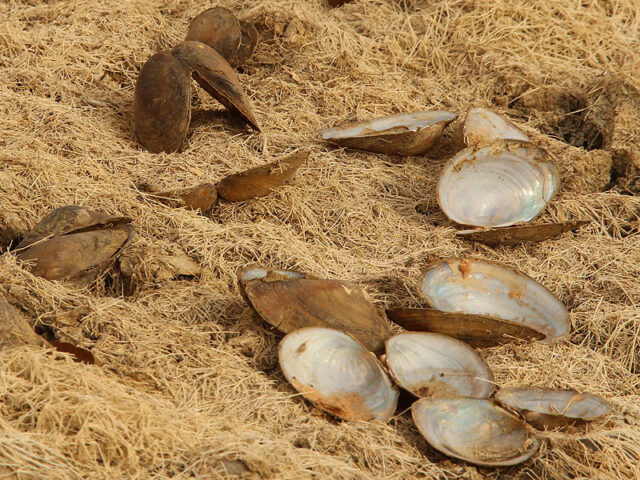
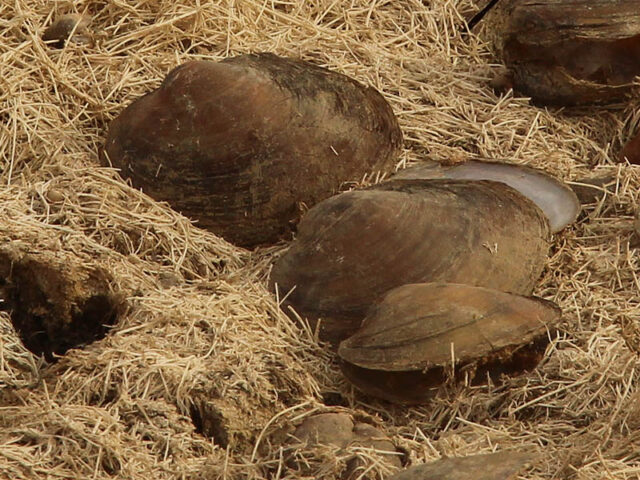
Virginia Opossum

I’ve been told that only people eat opossums. The implication is that these North American marsupials normally have little to fear from predators in the wild—and there might be a grain of truth to that. But to me, it seems like the opossum should be one of the most vulnerable critters on the North Texas landscape. They are slow moving, lacking in defenses, and don’t appear to be particularly bright.
Nonetheless, we have an abundance of these marsupials in Dallas/Fort Worth. The fact that we have as many of them as we do suggests there is a guardian angel of some sort looking out for these not-ready-for-primetime critters and keeping them safe. Could it be that their tactic of “playing possum” when threatened is their secret survival weapon? Here is what Wikipedia has to say about this unique behavior…
If threatened, an opossum will either flee or take a stand. To appear threatening, an opossum will first bare its 50 teeth, snap its jaw, hiss, drool, and stand its fur on end to look bigger. If this does not work, the Virginia opossum is noted for feigning death in response to extreme fear. This is the genesis of the term “playing possum”, which means pretending to be dead or injured with intent to deceive.
In this inactive state it lies limp and motionless on its side, mouth and eyes open, tongue hanging out, and feet clenched. Fear can also cause the opossum to release a green fluid from its anus with a putrid odor that repels predators. Heart rate drops by half, and breathing rate is so slow and shallow it is hardly detectable. Death feigning normally stops when the threat withdraws, and it can last for several hours. Besides discouraging animals that eat live prey, playing possum also convinces some large animals that the opossum is no threat to their young. “Playing possum” in response to threats from oncoming traffic often results in death.
Wikipedia
Despite their ability to thrive in North Texas, I still encounter opossum carcasses with some regularity when I am exploring outdoors. The cause of death in these cases is almost never readily apparent. Many of these remains show clear sign of having been scavenged, which often masks other more immediate causal evidence. It is reported that Virginia Opossums have a tragically short life expectancy—averaging only two years in the wild. It is certainly possible that many—if not all—of the example below simply perished of old age…
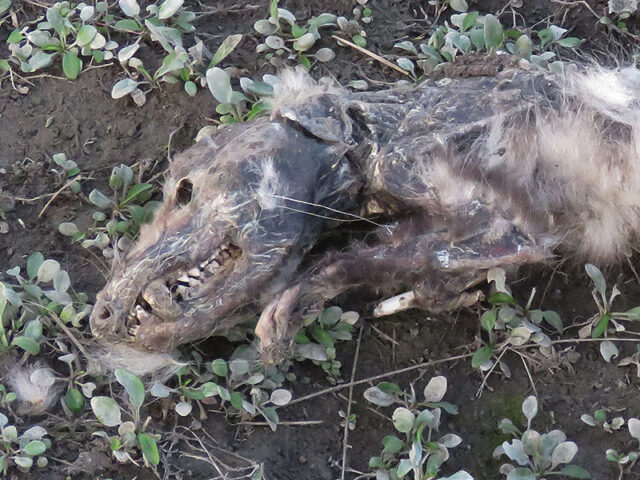
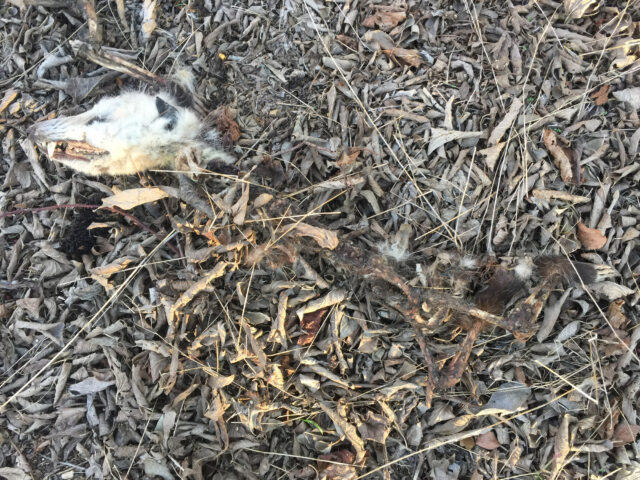
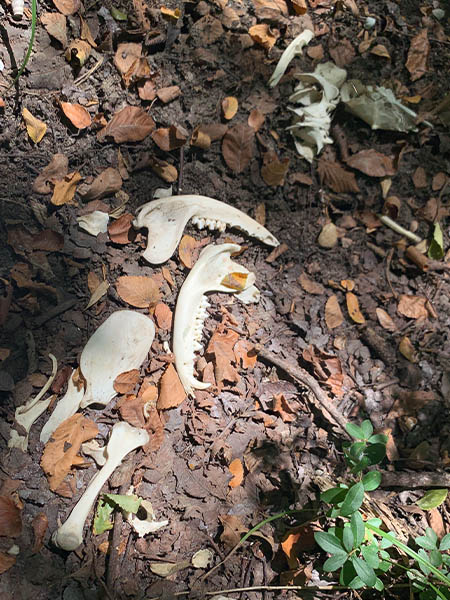
from an Opossum skeleton

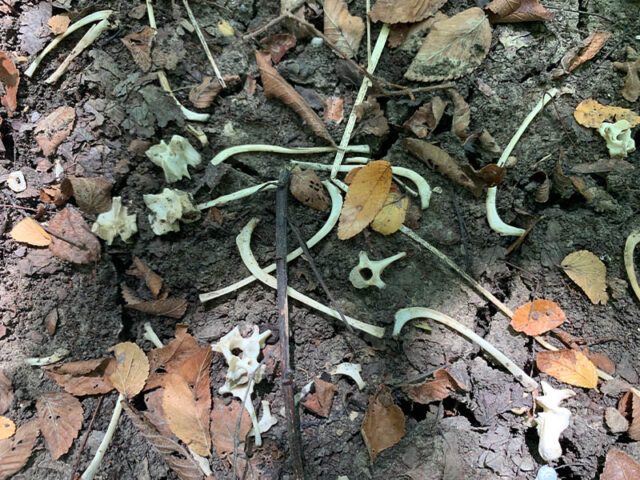
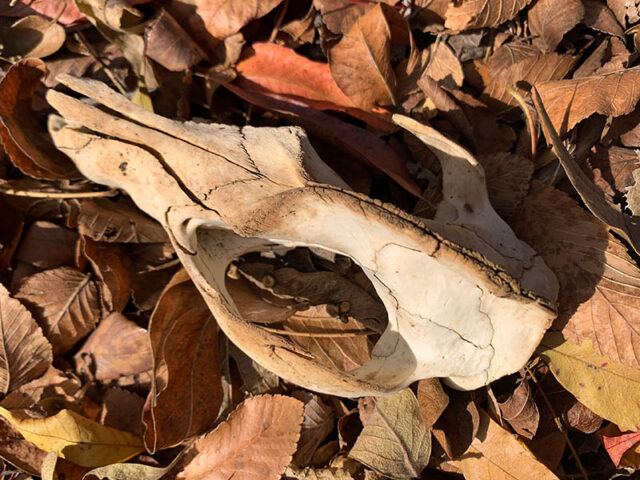
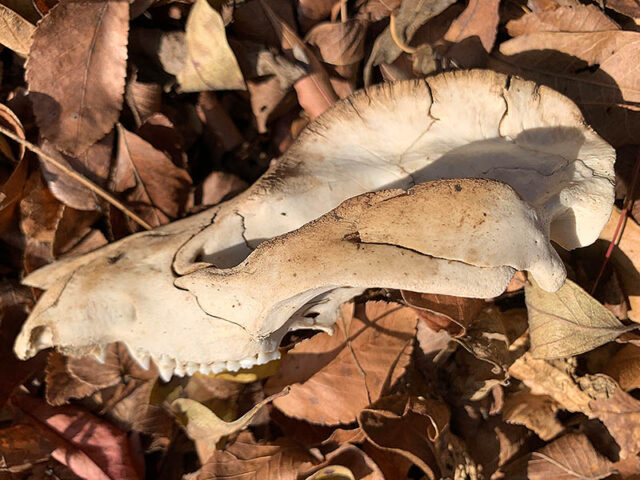
Odds and Ends
We’ll close with a few odds and ends. Skeletons that are more difficult to identify and explain, but still of some interest…
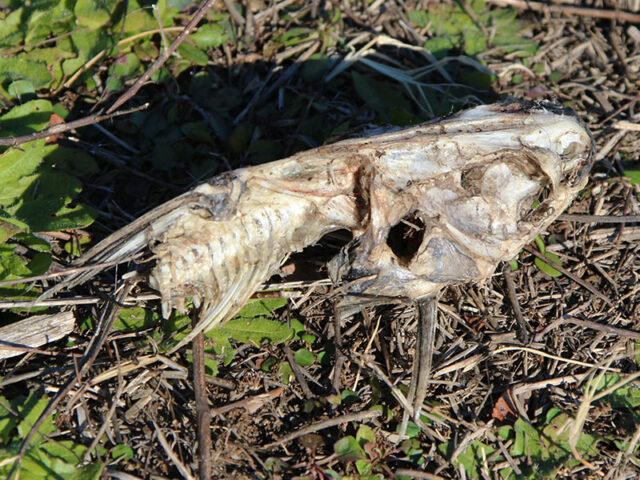

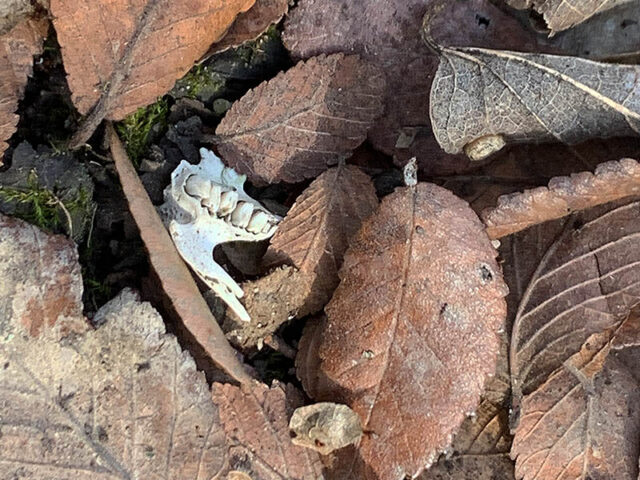
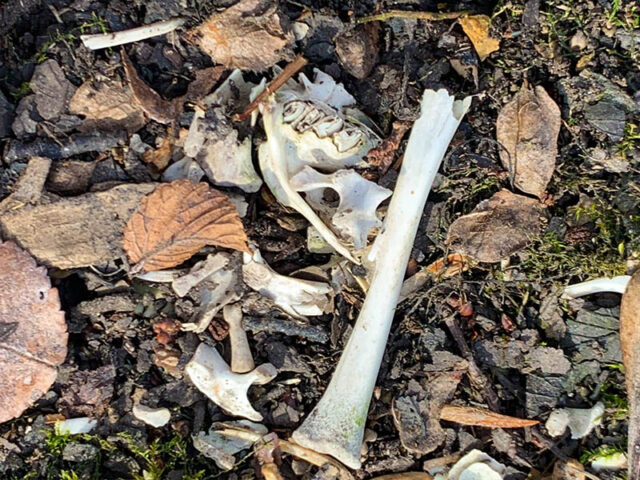
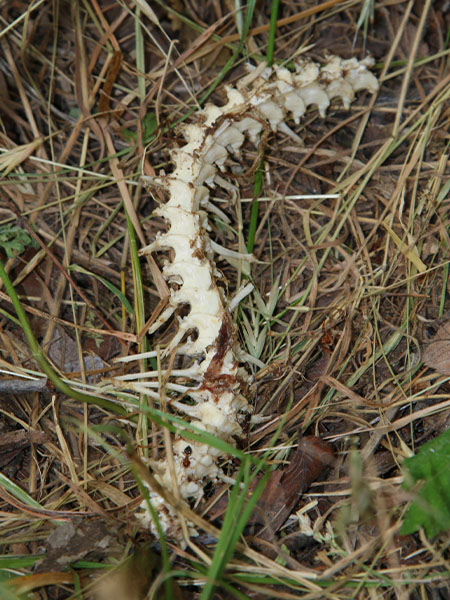


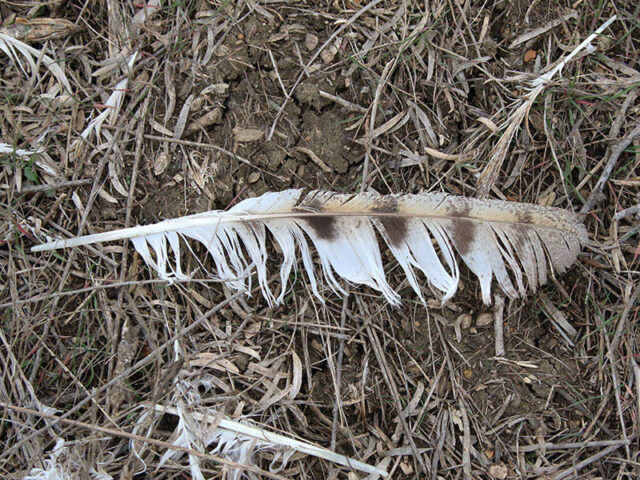


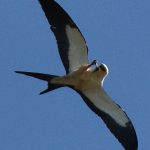
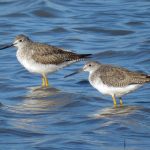

Very informative!
Have discovered skull in woods of Claremont nh? Need to know what animal it was?
Hi, great photos!
Sent you an email asking for an “okay” to use some of these photos as illustration references.